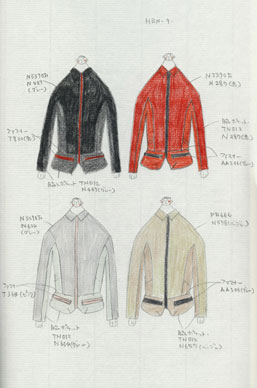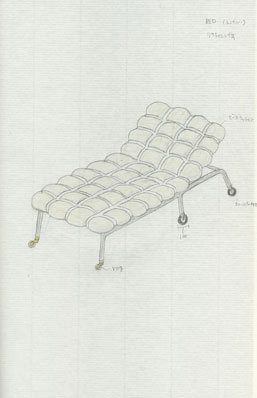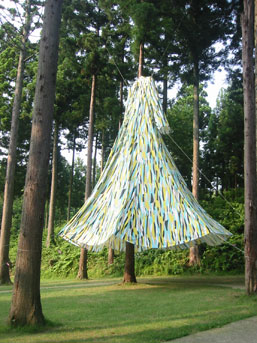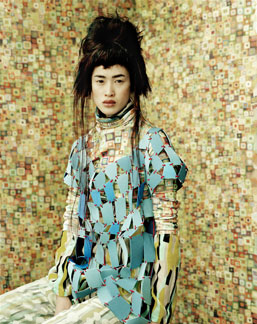Kodue Hibino’s Commodity Utopia
Mounting her first large scale museum exhibition, Kodue Hibino is presenting a selection taken from nearly twenty years of work, much of it from the past few years. Her selection runs the gamut from costume design to vases, from photography to apparel, from lamps to a rice cooker, and from shoes to beds. This is not a complete list, but even if it were Hibino would surely add a new product to the list before the exhibition finishes. Her work is that varied and prolific.
Color and texture are the strongest characteristics in Hibino’s work. Her attention to these details greets visitors with fifteen costumes in the first gallery. The designs range from a wearable collage of various materials and colors stitched together in a loose cacophonous net, to a lace and reinforced ribbon structural grid skirt, to a monolithic dark khaki fabric and sheer costume. Twelve accompanying sketchbooks show Hibino’s thought and design process through cartoon-like color pencil drawings. This is where her fantasies start and in the costumes and products come to life.


Hibino displays an extreme sensitivity to color, texture, and pattern that most strongly manifests itself in the smaller scale works: textiles, handkerchiefs, and rugs. Intricately constructed eyeglass sculptures and insect wing-inspired sunglasses, the sun-shielding effect due to the depth of slits rather than tinted glass. However, this attention to detail gives way to fairly conventional furniture. Wooden desks and kitchen counters are Euro-American country-style. Modernist steel framed sofas and recliners, while comfortable, lack the innovation of the smaller-scaled works.
The one exception to this scale anomaly results from going beyond the limits of convention: the extremely over-scaled and witty Soumoku no Doresu (Dress for Grass and Trees), is a giant tent-like dress suspended over a series of colorful cut-loop pile carpets (carpets of varying height fibers). After removing one’s shoes and walking under the translucent gown one can peer up the dress to see the colorful pattern become a backlit canopy of glowing leaves.
Hibino designed a series of outdoor apparel for The North Face. The garment giant produced her series of transformable clothes-bags, such as a shoulder bag that becomes a pair of pants through a series of zippings and foldings. Lacking the expressive color and texture of her previous work the clothing relies on the mass appeal of slick streamlined design, conservative colors with bright complimentary accents and its dynamic transformable character. During an opening performance Ryohei Kondo, of performance group Condors, staged a series of improvised vignettes using the clothing as costumes, characters, and props. The recorded performance is projected in the gallery.


As an exhibit of predominantly product design, the museum uniquely displays the works not only as art objects but also as the commodities that they are. The identification labels mimic retail store price tags as they dangle from string and display the artist and exhibition logo, product information (only in Japanese), and, most importantly the objects that are for sale – and most of them are – have their price displayed. The artist and curators do well to remind viewers that these objects began their existence as commercial product designs and continue to exist as such. The temporary shop at the end of the exhibit breaks ranks with the rest of the galleries only through quantity of items and the cash register. Even the Hibino-designed display shelves throughout the exhibition are for sale, presumably available for pick-up after the exhibit closes.
Getting to the Art Tower Mito is relatively easy, but it does take a commitment. Ranging from one to two hours, by train or bus respectively, getting there is not a quick trip. “Commodity Tune-up,” while thorough, seems a small reward for the travel. It is best to plan a day trip and see some of the ATM’s cinema, performance or concert offerings and visit other museums in the area.
James Way
James Way



